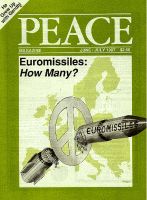
Peace Magazine Jun-Jul 1987, page 35. Some rights reserved.
Search for other articles by Brett Mann here
Graham T. Allison, Albert Camesale and Joseph S. Nye, Jr., eds. New York: Norton & Co., 1985.282 pp. Softcover, $8.95 Canadian.
It has been said that the only sin worse than not thinking about nuclear weapons is not thinking about them enough. Enough, that is to appreciate the complexities security in the nuclear age and to avoid possibly disastrous "solutions." Hawks, Doves and Owls edited by Allison, Camesale and Nye of Harvard University contributes a readable analysis of what Jonathan Schell calls the "theoretically sophisticated but humanly deficient world of strategic theory."
To the standard categories of "hawks" and "doves" is added a new type of bird, the "owl" whose concerns are focussed "primarily on loss of control and nonrational factors in history." Each perspective, it is argued in Hawks, Doves and Owls, has a valid contribution to make to the goal of avoiding nuclear war. While this view may offend some in the peace movement (and in the world of military strategy, for that matter), most peace workers may reluctantly accept that some degree of minimal nuclear deterrence will be needed until other guarantees of security, such as a Graham I Allison true international rule of law exists.
A paradox addressed in this Albert Camesale book, and too often overlooked by many in the peace movement, flows from the fact that a nuclear war is most likely to occur in the context of an escalating conventional war. Actions taken to lessen dependence on nuclear weapons, then, which inadvertently raise the risk of starting a conventional war, could become tragically counterproductive. For this reason, the editors of Hawks, Doves and Owls argue against adopting a no first use policy in Europe. Similarly, they call for a strengthening of NATO. Those in the peace movement who call for a dissolution of the Eastern and Western alliances to ease tension must at least consider the possible de-stabilizing consequences if such uncoupling were to lead a future government of, say, West Germany or South Korea, to decide it needed its own independent nuclear deterrent.
As well as raising such discomfiting scenarios, Hawks, Doves and Owls provides an analysis of the deep contributing and precipitating factors which could lead to a nuclear war from crises in Europe, the Middle East, and the Persian Gulf. One of the most valuable and fascinating chapters by Paul Bracken on accidental nuclear war states that the chances of a "pure" accidental nuclear war, arising from equipment failure or unauthorized launch were considerable in the 1950s but have declined to near zero today due to improved weapons and systems control and advanced technological safeguards. The chances of a preemptive, panicked nuclear strike arising from misperceptions during a crisis, however, have been increasing steadily since the mid '70s. According to Bracken, "the world may be edging toward an institutionalized nuclear showdown, one which is admittedly contingent on an external political shock to set it in motion, but one which may demonstrate how irrelevant many of our strategic and arms control ideas are to the security needs of the late twentieth century."
Perhaps the ten point agenda for avoiding nuclear war offered by Allison, Camesale, and Nye can be criticized as overly cautious. Presumably, the more certain the status quo is to lead to nuclear war, the more radical responses are justified.
Certainly, many will reject the editors' call for such actions as modernizing the strategic triad and rejecting a comprehensive nuclear freeze. Few activists will quarrel with the points of the agenda calling for enhanced crisis stability, reducing the impact of accidents, pursuing arms control, limiting misperceptions and related actions. The disturbing reality remains that most of the recommendations (such as "don't treat nuclear weapons like other weapons" or, "don't use nuclear alerts for political signalling") have repeatedly been ignored or actively opposed by both superpowers. The agenda offered by Hawks, Doves and Owls cannot be termed radical. It does raise a spectrum of legitimate questions which must be faced in the search for an escape from the dead end street presented by the nuclear arms race. That so few of the rather common sense actions proposed in Hawks, Doves and Owls have been adopted, especially by the West, underscores the need for a vocal, well informed peace movement.

Peace Magazine Jun-Jul 1987, page 35. Some rights reserved.
Search for other articles by Brett Mann here